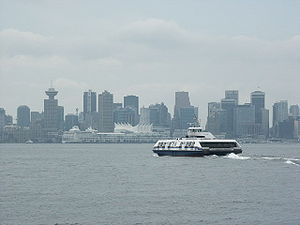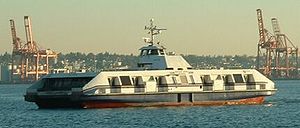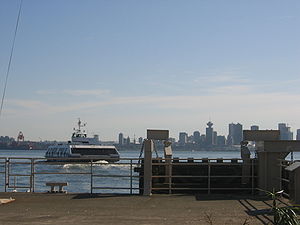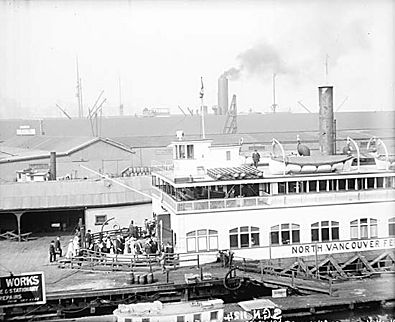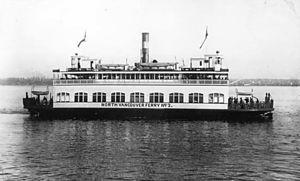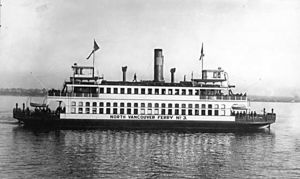SeaBus
The SeaBus is a Canadian passenger-only ferry service connecting the cities of Vancouver and North Vancouver, British Columbia. The SeaBus is owned and operated by the Coast Mountain Bus Company and is an important part of TransLink's integrated public transportation system.
Contents
Service
The ferries operate between approximately 6:00 a.m. and 1:00 a.m. daily. During the daytime from Monday to Saturday both ferries operate, with the two ferries departing simultaneously from opposite termini and passing each other halfway. The 1.75-nautical-mile (3.24 km) crossing takes 10-12 minutes in each direction with a cruising speed of 11.5 knots (21.3 km/h), with a 3-5 minute turnaround and, therefore, operates on a 15 minute turn-around schedule.[1] At these times, over 50 crossings are made a day. During the evenings and on Sundays, service is reduced to a 30 minute schedule with only one ferry operating.
The SeaBus is capable of operating on a 12 minute turnaround (or even 10 minutes with simultaneous loading and unloading). However, at the higher speeds, the wake created disturbs other users of the Burrard Inlet. During overloads they do sometimes operate at the higher speeds.
The turnstiles on the entrance into the SeaBus waiting area are used only for counting the number of passengers boarding the SeaBus. When the maximum number is reached the turnstiles will "lock" and no more passengers will be allowed on that SeaBus.
Traditionally, like all public transit in Vancouver, the SeaBus offers free rides on New Year's Eve to discourage drinking and driving. See also: TransLink fares (Vancouver).
Seabus is designated a "Fare Paid Zone" similar to SkyTrain and buses. This means passengers are required by law to retain their transfer or transit pass in the Fare Paid Zone. Constables from the South Coast British Columbia Transportation Authority Police Service, as well as Transit Security Officers conduct random fare inspections. Failure to pay the correct fare or retain their transit pass can result in a $173 fine and/or removal from the terminal.
Termini
The SeaBus stops on the Vancouver side at Waterfront Station, near the Vancouver Convention Centre and cruise ship terminal at Canada Place. At Waterfront Station, there are connections to the SkyTrain and West Coast Express. In North Vancouver, the SeaBus stops at the purpose-built Lonsdale Quay, which in addition to serving many commuters has become an important tourist destination, with a hotel, public market, and bus loop.
Construction and operations
The ferries are catamaran ferries constructed out of aluminium, which was quite rare when the initial two craft were constructed in the 1970s. The ferries are double ended so that they can travel in either direction without turning around. There are four diesel engines in each hull, one for each propeller. The propulsion system uses a marine version of the same diesel engine used to power many of the diesel buses on the transit system. The ferries can operate with only three propellers if required.
With the radar, the ferries are able to operate in even the densest fog.
The original emergency procedure involved using the other SeaBus to evacuate passengers from the distressed SeaBus. Although the viability of this had been demonstrated, Transport Canada became concerned about this approach during times that the other SeaBus may not be available and has recently mandated the addition of life rafts.
As there are no spare ferries, all refits and upgrades have been done during a long weekend when the half hour service can be maintained with one boat. Changing an engine and minor refits can be done during the out of service time overnight. Despite running for nearly three decades, the two ships are rarely taken out of service for maintenance, boasting a 99.92% service reliability[2], a record unparalleled in North America.
The ferries operate with four crew on board (Captain and First Mate on the bridge and two attendants on the passenger level) and engineers who stay ashore most of the time, but do regular checks of the engines and are available to come aboard at any time.
In terms of design scheme, both original SeaBus craft were painted and remained a bright orange colour until 1985. To accommodate Vancouver's Expo 86, the city's then-transit authority BC Transit changed the design scheme to white with one red and one blue stripe as well as a BC flag label, matching SeaBus with the then newly built SkyTrain system and newly ordered bus fleet. This remained until the 1999/2000 handover of BC Transit to Metro Vancouver's present transportation administration, TransLink. The paint scheme has since been white or grey with blue and golden yellow strips across the sides of the ferries.
Ferries
- MV Burrard Otter (1976 - Vancouver) - seats 400
- MV Burrard Beaver (1976 - Victoria) - seats 400
- MV Burrard Pacific Breeze (2009 - Vancouver/Victoria) - seats 400[3]
The third vessel, the Burrard Pacific Breeze[4], began service in December 2009, and TransLink operated all three ferries during the 2010 Winter Olympics. TransLink originally planned to provide regular 3-vessel service by 2011 by overhauling and refitting both the Burrard Otter and the Burrard Beaver following the games to extend their service life for an additional twenty years.[5] However, citing the lack of funding, the agency now plans to upgrade only one of the original vessels, and retire the other one; another new ferry will be commissioned instead if funding becomes available in the future.[6]
Fuel efficiency
The Vancouver SeaBus uses 83 kilowatt-hours per vehicle-kilometre, at a speed of 13.5 kilometres per hour. When full (i.e. when seating 400 people), the energy used is 0.21 kilowatt-hours per passenger-kilometre.[7]
History
The first regular service between the City of North Vancouver and Vancouver began in 1900 with the craft North Vancouver. Three years later, the North Vancouver Ferry and Power Company was created, took over, and built a new craft called St. George. These two ferries were later renamed North Vancouver Ferry No. 1 and North Vancouver Ferry No. 2. The City of North Vancouver took over the service in 1908 to provide a more reliable ferry connection with Downtown Vancouver. Soon after, another craft, North Vancouver Ferry No. 3 was built. In 1936, the No. 2 was retired and used as a logging camp on the west coast of Vancouver Island until it was destroyed by fire.
In 1938, the Lions' Gate Bridge was completed and took away much business from the ferries, however, there was an increased demand with the onset of World War II because of the shipbuilding boom in North Vancouver. This growth in business spurred the creation of a new ferry, the North Vancouver Ferry No. 5, in 1941. The Crosline was also leased from Washington to meet demands. According to Capt. James Barr, 1943 was the busiest year that North Vancouver Ferries had, ferrying over 7 million passengers across the Burrard Inlet.
The North Vancouver No. 5 was built in Coal Harbour by Boeing Shipyards in 1931. She ran faithfully with her Union Diesel until 1958 when she was tied up at the foot of Lonsdale Ave along with North Vancouver Ferry No 4. Capt. Jesse Oliver Kinnie, a North Vancouver Ferry employee looked into the possibility of purchasing North Vancouver Ferry No. 4 and running it on the same route as she had run all her life. She had a higher height clearance on the car deck than Ferry No 5 and was faster. The numbers did not add up and the plan was abandoned. Number 4 ferry also ran on a Union Diesel.
The ferries were in major decline by the 1950s. In 1948 the No. 3 was taken off of regular service and was sold in 1953. The cost of operating the ferries was too high and in 1958 and the last sailing took place on August 30 by the No. 4 ferry. The No. 4 was later sold to be used in Prince Rupert. Later, No. 4 returned to Vancouver and was tied up on the Vancouver side of Burrard Inlet. She was in desperate need of a refit and had to be kept afloat with pumps to keep the water out of her hull. When the power failed and the pumps stopped she went to the bottom. The No. 5 was converted into the Seven Seas Restaurant at the foot of Lonsdale in North Vancouver. It remained there until 2002 when the City of North Vancouver and the federal courts had it demolished after a long standing dispute who would be responsible if it sank and concern that the hull was in danger of imminent collapse. In dry dock it proved to be quite sound, but at that point the decision had already been made to scrap it and a piece of heritage was lost.
The current ferries began operating the same route in 1977. The SeaBus system was built with money originally slated for a proposed (and quashed) freeway crossing across Burrard Inlet. For the first few years of service, the automated fare machines (the first in Vancouver's transit system) at the two SeaBus terminals photocopied the rider's coins onto a cash-register-style receipt, which could become very long if fares were paid in small-denomination coins such as pennies.
References
- ↑ Coast Mountain Bus Company
- ↑ SeaBus facts
- ↑ Passenger house of third SeaBus arrives at Victoria Shipyards
- ↑ New SeaBus named Burrard Pacific Breeze
- ↑ Name the SeaBus Contest
- ↑ SeaBus fleet grows for Olympics, but won't last, CTV News, December 23, 2009. Accessed online January 16, 2010.
- ↑ David J.C. MacKay. Sustainable Energy – without the hot air. UIT Cambridge, 2008. ISBN 978-0-9544529-3-3. http://www.withouthotair.com. p. 120.
| ||||||||
cs:SeaBus de:SeaBus ja:シーバス (バンクーバー) no:SeaBus sk:SeaBus fi:SeaBus zh:海上巴士
